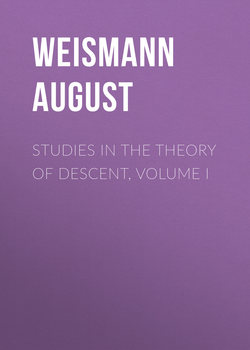Studies in the Theory of Descent, Volume I

Реклама. ООО «ЛитРес», ИНН: 7719571260.
Оглавление
Weismann August. Studies in the Theory of Descent, Volume I
PREFATORY NOTICE
TRANSLATOR’S PREFACE
PREFACE TO THE ENGLISH EDITION
Part I. ON THE SEASONAL DIMORPHISM OF BUTTERFLIES
I. The Origin and Significance of Seasonal Dimorphism
II. Seasonal Dimorphism and Climatic Variation
III. Nature of the Causes producing Climatic Varieties
IV. Why all Polygoneutic Species are not Seasonally Dimorphic
V. On Alternation of Generations
VI. General Conclusions
APPENDIX I. EXPERIMENTS
APPENDIX II
EXPLANATION OF THE PLATES
Part II. ON THE FINAL CAUSES OF TRANSFORMATION
I. THE ORIGIN OF THE MARKINGS OF CATERPILLARS
INTRODUCTION
I. Ontogeny and Morphology of Sphinx-Markings
II. Conclusions from Phylogeny
III. Biological Value of Marking in General
IV. Biological Value of Colour
V. Biological Value of Special Markings
VI. Objections to a Phyletic Vital Force
VII. Phyletic Development of the Markings of the Sphingidæ: Summary and Conclusion
II. ON PHYLETIC PARALLELISM IN METAMORPHIC SPECIES
INTRODUCTION
Отрывок из книги
In offering to English readers this translation of Professor Weismann’s well-known “Studies in the Theory of Descent,” the main part of which is devoted to entomological subjects, I have been actuated by the desire of placing in the hands of English naturalists one of the most complete of recent contributions to the theory of Evolution as applied to the elucidation of certain interesting groups of facts offered by the insect world. Although many, if not most, working naturalists are already familiar with the results of Dr. Weismann’s researches, of which abstracts have from time to time appeared in English and American scientific journals, I nevertheless believe that a study of the complete work, by enabling the reader to follow closely the detailed lines of reasoning and methods of experiment employed by the author, will be found to be of considerable value to those biologists who have not been able to follow the somewhat difficult phraseology of the original. It is not my intention, nor would it be becoming in me to discuss here the merits of the results arrived at by the minute and laborious investigations with which Dr. Weismann has for many years occupied himself. I may however point out that before the appearance of the present work the author, in addition to his well-known papers on the embryology and development of insects, had published two valuable contributions to the theory of descent, viz. one entitled “Über die Berechtigung der Darwin’schen Theorie” (1868), and another “Über den Einfluss der Isolirung auf die Artbildung” (1872). These works, which are perhaps not so well known in this country as could be desired, might be advantageously studied in connection with the present volume wherein they are frequently referred to.
Since every new contribution to science is a fresh starting-point for future work, I may venture without any great breach of propriety to dwell briefly upon one or two of the main points which appear to me to be suggested by Prof. Weismann’s investigations.
.....
That an unusually high temperature may cause reversion, I conclude from the following observation. In the summer of 1869 I bred the first summer brood of A. Levana; the caterpillars pupated during the second half of June, and from that time to their emergence, on 28th June–3rd July, great heat prevailed. Now, while the intermediate form Porima had hitherto been a great rarity, both in the free state and when bred, having never obtained it myself, for example, out of many hundreds of specimens, there were among the sixty or seventy butterflies that emerged from the above brood, some eight to ten examples of Porima. This is certainly not an exact experiment, but there seems to me a certain amount of probability that the high summer temperature in this case brought about reversion.
Neither for the second cause to which I have ascribed the power of producing reversion can I produce any absolute evidence, since the experimental solution of all these collateral questions would demand an endless amount of time. I am in possession of an observation, however, which makes it appear probable to me that continuous mechanical movement acts on the development of the pupæ in a similar manner to cold, that is, retarding them, and at the same time producing reversion. I had, in Freiburg, a large number of pupæ of the first summer brood of Pieris Napi, bred from eggs. I changed residence while many caterpillars were in course of transformation and travelled with the pupæ in this state seven hours by rail. Although this brood of P. Napi, under ordinary circumstances, always emerges in the summer, generally in July of the same year, as the summer form (var. Napeæ), yet out of these numerous pupæ I did not get a single butterfly during the year 1872. In winter I kept them in a warm room, and the first butterflies emerged in January, 1873, the remainder following in February, March, and April, and two females not until June. All appeared, however, as exquisite winter forms. The whole course of development was precisely as though cold had acted on the pupæ; and in fact, I could find no other cause for this quite exceptional deportment than the seven hours’ shaking to which the pupæ were exposed by the railway journey, immediately after or during their transformation.
.....